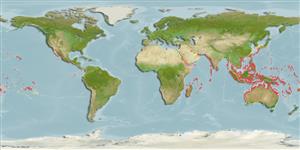Common names from other countries
Environment: milieu / climate zone / depth range / distribution range
Sinh thái học
; Mức độ sâu 0 - 81 m (Ref. 104607), usually 0 - 20 m (Ref. 75831). Tropical
Indo-Pacific: from East Africa, to eastern Polynesia; north to southern Japan and south to Queensland.
Length at first maturity / Bộ gần gũi / Khối lượng (Trọng lượng) / Age
Maturity: Lm ? range ? - ? cm Max length : 4.0 cm SHH con đực/không giới tính; (Ref. 348); common length : 3.0 cm SHH con đực/không giới tính; (Ref. 348)
Commonly collected in many areas, mainly for decorative purposes.
Life cycle and mating behavior
Chín muồi sinh dục | Sự tái sinh sản | Đẻ trứng | Các trứng | Sự sinh sản | Ấu trùng
Members of the class Bivalvia are mostly gonochoric, some are protandric hermaphrodites. Life cycle: Embryos develop into free-swimming trocophore larvae, succeeded by the bivalve veliger, resembling a miniature clam.
Poutiers, J.M. 1998. (Ref. 348)
IUCN Red List Status (Ref. 130435: Version 2024-1)
CITES status (Ref. 108899)
Not Evaluated
Not Evaluated
Threat to humans
Harmless
Human uses
| FishSource |
Các công cụ
Thêm thông tin
Age/Size
Sự sinh trưởng
Length-weight
Length-length
Hình thái học
Ấu trùng
Sự phong phú
Các nguồn internet
Estimates based on models
Preferred temperature
(Ref.
115969): 24.4 - 29, mean 28 (based on 1118 cells).
Vulnerability
Low vulnerability (10 of 100).
